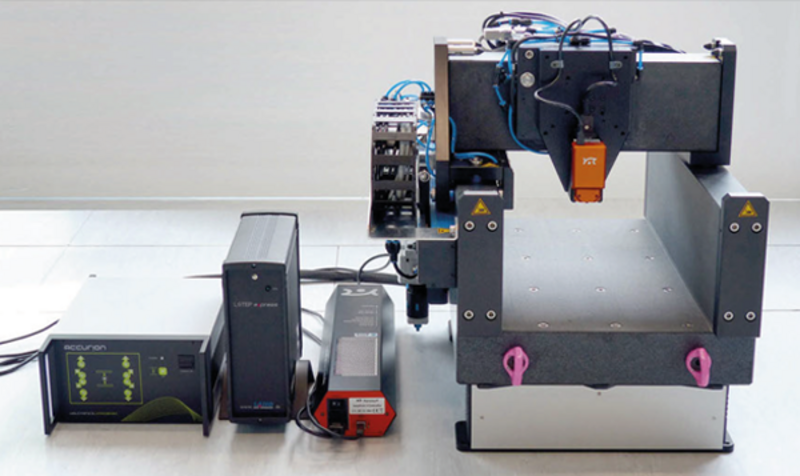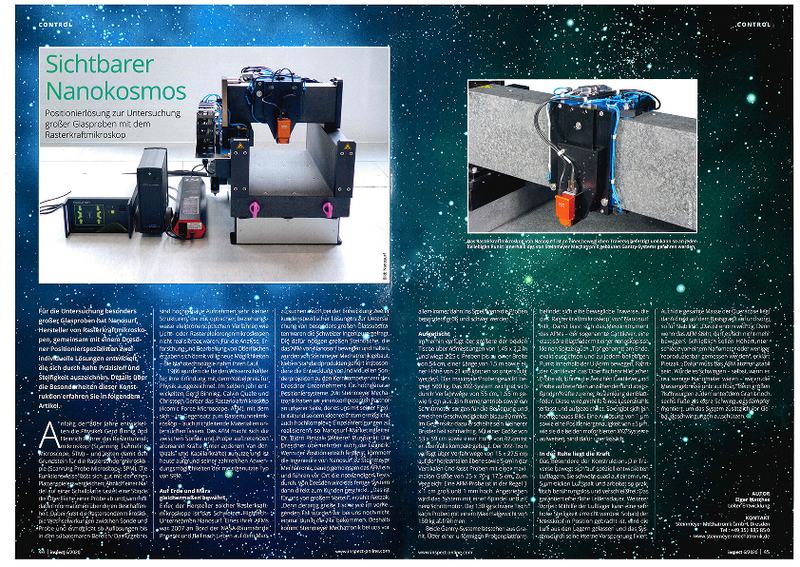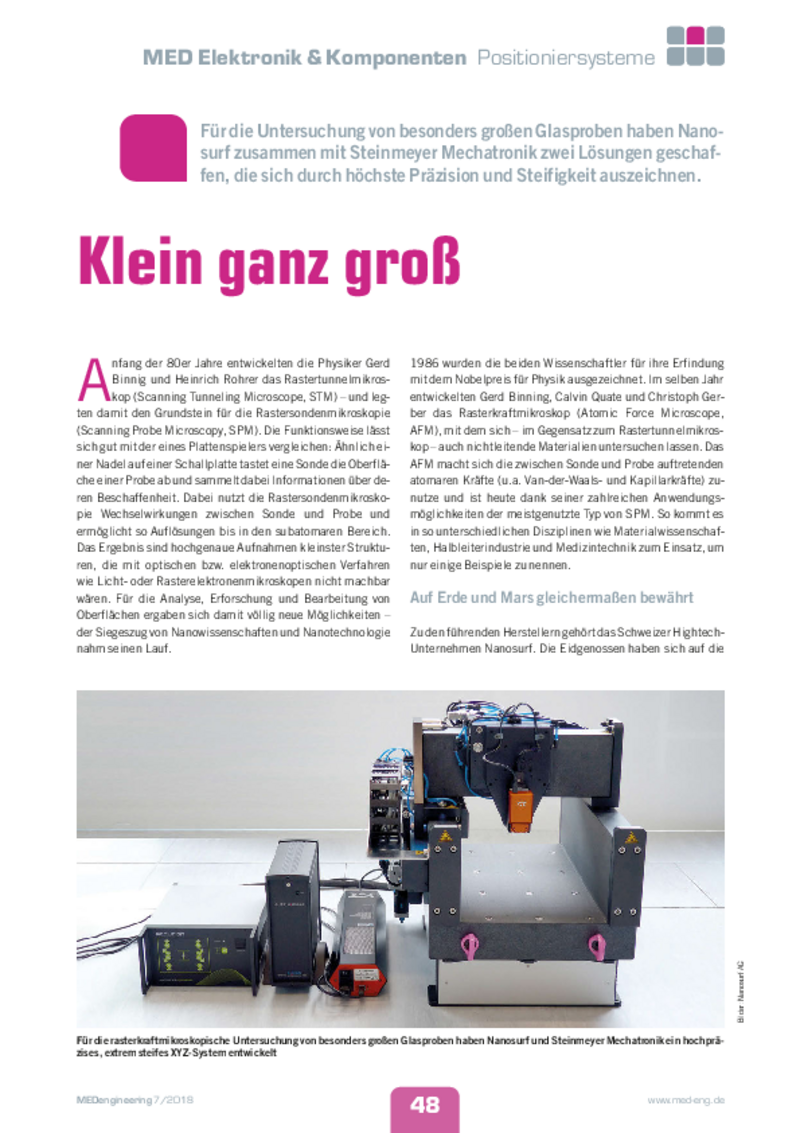2020/10 | For the atomic force microscopy investigation of particularly large glass samples, Nanosurf and Steinmeyer Mechatronics have developed a high-precision, extremely rigid XYZ system.
Small all the way
Nanosurf and Steinmeyer Mechatronik make the nanocosmos visible
The Swiss high-tech company Nanosurf is one of the leading manufacturers of atomic force microscopes. Together with the Dresden-based positioning specialist Steinmeyer Mechatronik, the Swiss company has created two individual solutions for the examination of particularly large glass samples that are characterized by maximum precision and rigidity..
At the beginning of the 1980s, physicists Gerd Binnig and Heinrich Rohrer developed the scanning tunneling microscope (STM) - and thus laid the foundation for scanning probe microscopy (SPM). The way it works can easily be compared to that of a record player: Similar to a needle on a record, a probe scans the surface of a sample, collecting information about its nature. Scanning probe microscopy makes use of interactions between the probe and the sample, thus enabling resolutions down to the subatomic range. The result is highly accurate images of the smallest structures, which would not be possible with optical or electron-optical methods such as light or scanning electron microscopes. This opened up completely new possibilities for the analysis, research and processing of surfaces - the triumphant advance of nanoscience and nanotechnology took its course.In 1986, the two scientists were awarded the Nobel Prize in Physics for their invention. In the same year, Gerd Binning, Calvin Quate and Christoph Gerber developed the atomic force microscope (AFM), which - in contrast to the scanning tunneling microscope - can also be used to study non-conducting materials. The AFM makes use of the atomic forces occurring between the probe and the sample (including Van der Waals and capillary forces) and is now the most widely used type of SPM thanks to its numerous possible applications.
Proven on Earth and Mars alike
One of the leading manufacturers is the Swiss high-tech company Nanosurf. The Swiss specialize in the development of scanning probe microscopes and offer compact AFMs and STMs, state-of-the-art atomic force microscope systems for scientific applications as well as individual solutions for specific requirements. Around the globe, customers from industry as well as research & education appreciate the innovative approach, the modularity as well as the easy handling of the products. In 2007, an AFM from Nanosurf was also on board NASA's "Phoenix" space probe to Mars, helping to search for life on the red planet. Needless to say, this was not an "off the shelf" model. Understanding the requirements, responding to them and developing an exactly fitting solution - that is one of Nanosurf's strengths. The creativity of the Swiss engineers was also called for in the development of two customer-specific solutions for the examination of particularly large glass subtrates. The large stone tables required to move and hold Nanosurf's AFM were built by Steinmeyer Mechatronik.
From Dresden to the whole world
For more than 145 years, the name Steinmeyer Mechatronik has stood for quality and precision. In addition to standard products, the development of individual special projects in particular is one of the core competencies of the Dresden-based specialists for high-precision positioning systems. Together with the customer, the company develops innovative concepts perfectly tailored to the respective application. It is precisely this solution competence that Nanosurf particularly appreciates about the Saxons. "With Steinmeyer Mechatronik, we have a competent partner at our side whose flexibility and wealth of ideas enable us to realize even highly complex custom products," says Nanosurf marketing manager Dr. Björn Pietzak. Another plus point is that the Dresden-based company also handles the logistics. When the positioning table is ready, Nanosurf engineers come to Steinmeyer Mechatronik, jointly install the AFM and perform the necessary tests on site. From Dresden, the finished system is then sent directly to the customer. "This is a great advantage for us," Dr. Pietzak tells us. "Because we wouldn't even be able to get such large tables as in this case through the door. That's why Steinmeyer Mechatronik always comes into play for us when the samples are particularly large and heavy."
Served up
After all, the larger of the two stages has dimensions of 1.45 m x 2.2 m and weighs 2.25 tons. Specimens up to a width of 54 cm, a length of 1.5 m and a height of 21 cm can be examined. The maximum sample weight is 500 kg. Since the specimen is firmly fixed on the platform, the XYZ system scores points for compactness and manages travel distances of 55 cm, 1.55 m and 5 cm. A belt drive and a stepper motor provide the movement and achieve speeds of up to 30 mm/s. In contrast, its smaller brother appears almost slender, although it also has impressive dimensions. With a size of 53 x 59 cm and a height of 47 cm, it is also extremely compact. The XYZ stage has travel ranges of 15 x 27.5 cm on the horizontal plane and 5 cm in the vertical plane and holds samples with a maximum size of 25 x 70 x 17.5 cm. For comparison, a "normal" AFM sample is typically 1 x 1 cm and 1 mm high. The system is driven by a spindle and a stepper motor. The 130 kg stage can hold samples with a maximum weight of 150 kg.
Both gantry systems are made of heavy granite to withstand the large weight of the specimens. Above a u-shaped sample platform is a movable crosshead that holds Nanosurf's atomic force microscope. This allows the AFM's measuring instrument - called a cantilever, an elastic leaf spring with a nanoscopically small tip (also called a "tip") at the end - to be precisely aligned and moved to any point within the U-shape. When the cantilever traverses the surface relief of a sample, the attractive and repulsive forces occurring between the cantilever and the sample cause the leaf spring to deflect. This is detected and recorded with the aid of a laser beam. This produces a highly accurate image. A resolution of 1 µm and a positioning accuracy of +-5 µm, as provided by the two motorized XYZ systems, are essential for this.
The power is in the quiet
The special feature of the design: The crosshead moves on specially developed air bearings. It virtually floats on an approx. 5 µm thick air gap and thus operates practically contactless and wear-free. This guarantees a very long service life. A further advantage is that extreme rigidity can be achieved with the aid of the air bearings. As soon as the measuring head is brought into position, the air is released from the bearings and the system is fixed by its internal preload. The entire mass of the transverse axis then also rests directly on the base granite, ensuring maximum stability. "This is enormously important. Because when the AFM is stationary, it must not move. After all, height differences of one nanometer or less should be measured reproducibly," explains Dr. Pietzak. "For this, the AFM must be atomically stable. If it were to oscillate - even if it were only a few nanometers - the measurement results would be unusable." In the case of the large table, moreover, six feet were mounted under the granite as extra vibration dampers to further protect the system from building vibrations.
This extraordinary rigidity was not an everyday occurrence for Steinmeyer Mechatronik either. "We ourselves would not have had the opportunity to prove whether our tables even met the required high stiffness requirements," reports Reinhard Weihmann of Steinmeyer Mechatronik. But thanks to the intensive cooperation with Nanosurf and their joint years of experience with such heavyweights, the Dresden-based positioning specialists solved this challenge with flying colors. The two companies have already been working together for more than ten years and are a well-established team. "We complement each other perfectly," says Dr. Pietzak. "We do the calculations and Steinmeyer Mechatronik supplies us with the finished product in high quality. It's a great fit."
Author: Elger Matthes, Development Manager, Steinmeyer Mechatronik



